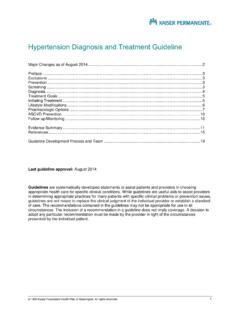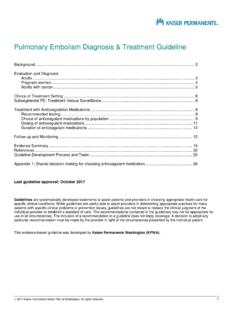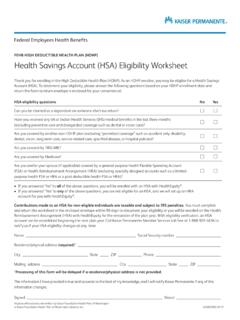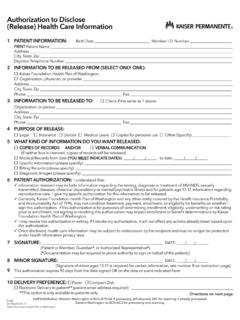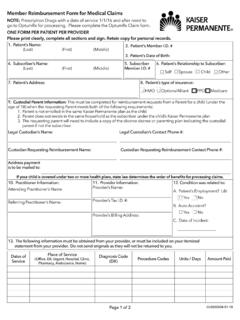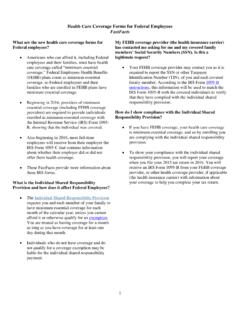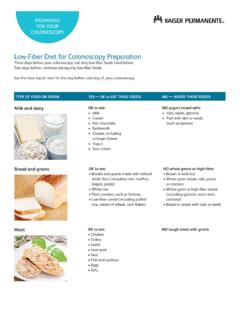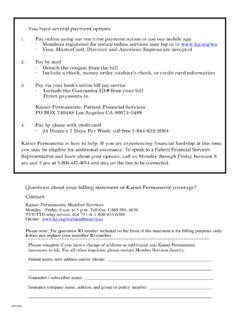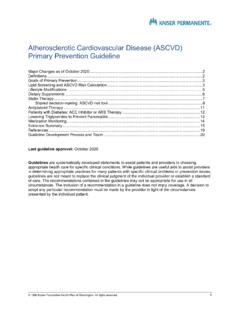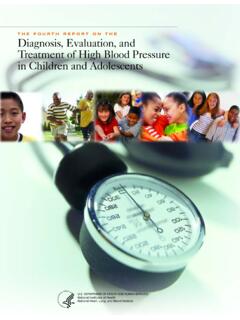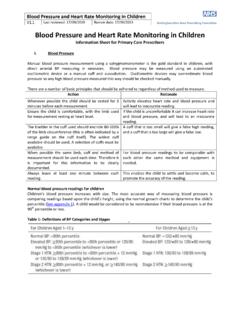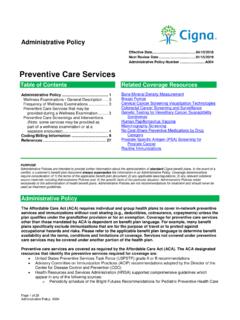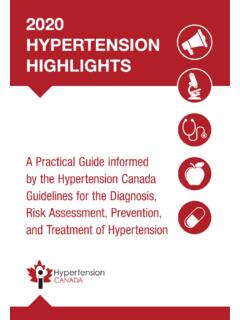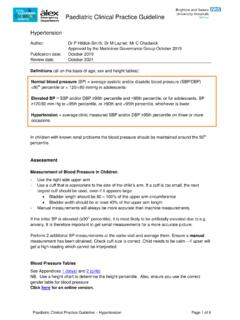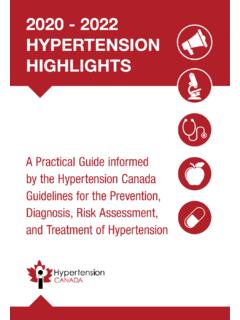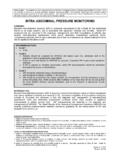Transcription of Type 2 Diabetes Screening and Treatment Guideline
1 1996 Kaiser Foundation Health Plan of Washington. All rights Type 2 Diabetes Screening and Treatment Guideline Major Changes as of April 2019 .. 2 Prevention .. 2 Screening and Tests .. 2 3 Treatment .. 4 Risk-reduction goals .. 4 Lifestyle modifications and non-pharmacologic options .. 4 Bariatric surgery .. 6 Pharmacologic options for glucose control .. 6 Type 2 Diabetes Treatment workflow for Primary Care .. 9 Type 2 Diabetes Treatment : when to consider glargine or U-500 insulin ..10 Additional pharmacologic options to consider in consultation with Diabetes Team.
2 11 Pharmacologic options that are not recommended ..12 Referral to Nursing or Clinical Pharmacy ..13 Follow-up and Monitoring ..14 Self blood glucose monitoring ..14 Periodic monitoring of conditions and complications ..15 Medication monitoring ..15 Recommended immunizations ..16 Comorbidities ..16 Evidence Summary ..17 References ..21 Guideline Development Process and Team ..23 Last Guideline approval: April 2019 Guidelines are systematically developed statements to assist patients and providers in choosing appropriate health care for specific clinical conditions.
3 While guidelines are useful aids to assist providers in determining appropriate practices for many patients with specific clinical problems or prevention issues, guidelines are not meant to replace the clinical judgment of the individual provider or establish a standard of care. The recommendations contained in the guidelines may not be appropriate for use in all circumstances. The inclusion of a recommendation in a Guideline does not imply coverage. A decision to adopt any particular recommendation must be made by the provider in light of the circumstances presented by the individual patient.
4 2 Major Changes as of April 2019 New Previous Monitoring for lipohypertrophy and lipodystrophy is now recommended. _ Because glimepiride has been added to the Beers list of drugs to avoid in the elderly, sulfonylurea recommendations are now as follows: Glimepiride continues to be recommended for patients aged < 65 years with no CKD or renal dysfunction trend (for a favorable cardiovascular profile). Glipizide is now recommended for patients aged 65 years and older (for kidney disease toxicity avoidance to avoid excessive prolonged hypoglycemia).
5 The type 2 Diabetes Treatment workflow has been updated to reflect these changes. Glimepiride was not on the Beers list and was the preferred sulfonylurea regardless of patient age. The coverage criteria for the formulary (prior authorization) SGLT-2 empagliflozin were updated to add a third qualifying subgroup of type 2 Diabetes patients: those with HbA1c 9% and either clinically significant weight gain or BMI 35 prior to insulin therapy. Coverage criteria for empagliflozin did not take HbA1c level or BMI into consideration.
6 The KPWA coverage criteria for the non-formulary GLP-1 receptor agonists exenatide XR (Bydureon) and liraglutide (Victoza) were updated to require a minimum 3-month trial of empagliflozin before starting. A 3-month trial of empagliflozin was not required prior to starting exenatide XR or liraglutide. Prevention Studies have shown that increasing physical activity and eating a healthy diet can significantly delay the onset of type 2 Diabetes , including for patients diagnosed with impaired glucose tolerance. Studies have also shown that the use of metformin can delay the diagnosis of Diabetes for patients with impaired glucose tolerance, but there is no evidence that metformin or any other medication leads to long-term better clinical outcomes prior to diagnosis of Diabetes .
7 Screening and Tests The Preventive Services Task Force (Siu 2015) recommends Screening patients who are at increased risk for Diabetes . Risk factors for type 2 Diabetes include: Age of 45 years or older Overweight or obesity (BMI 25) First-degree relative with Diabetes Polycystic ovarian syndrome (in women) Certain racial/ethnic backgrounds, including African American, American Indian/Alaska Native, Asian American, Hispanic/Latino, and Native Hawaiian/Pacific Islander 3 It is reasonable to have a higher clinical index of suspicion in adults with multiple risk factors and to use clinical judgment or shared decision-making about whether to screen these individuals for type 2 Diabetes .
8 If the decision is to screen, consider a frequency of every 3 years using either fasting plasma glucose or HbA1c. Adults at high risk for atherosclerotic cardiovascular disease (see the KPWA guidelines for primary and secondary prevention of ASCVD) should be considered for Screening . While ASCVD itself is not a risk factor for type 2 Diabetes , type 2 Diabetes is a serious complicating comorbidity in patients with ASCVD. If they elect Screening , these patients should be screened every 3 years using either fasting plasma glucose or HbA1c.
9 Annual Screening is recommended for women with a history of gestational Diabetes (using HbA1c) and for men and women with impaired fasting blood glucose (using either fasting plasma glucose or HbA1c). Diagnosis Diagnosis for an asymptomatic patient requires two abnormal test results, which can be from the same test performed on different days, or from different tests performed on either the same day or different days. If only one test comes back abnormal, repeat the abnormal test on a different day. An abnormal result on the repeated test is diagnostic for Diabetes .
10 Diagnosis for a patient with classic symptoms of hyperglycemia ( , polyuria, polydipsia, weight loss) can be made with a single random plasma glucose result of 200 mg/dL or higher. A repeat measurement is not needed. Table 1. Diagnosing Diabetes Test Results Interpretation HbA1c or higher Diabetes Impaired glucose tolerance 1 Lower than Normal Random plasma glucose 200 mg/dL or higher Diabetes 140 199 mg/dL Impaired glucose tolerance 1 Lower than 140 mg/dL Normal Fasting plasma glucose 126 mg/dL or higher Diabetes 100 125 mg/dL Impaired glucose tolerance 1 Lower than 100 mg/dL Normal 1 Impaired glucose tolerance (IGT) is similar to impaired fasting glucose (IFG)
